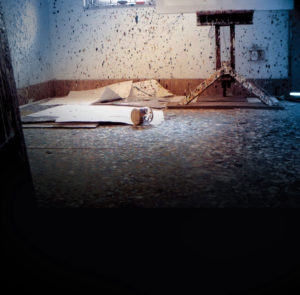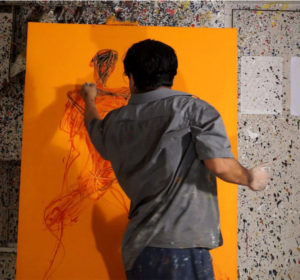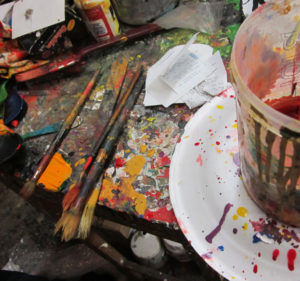Agile and Unrestrained
Susmit Biswas constantly experiments with the fine line between imagery and abstraction which frequently results in a resonant balance,
permeating his work with a sense of dynamism and vigour. His art is one of captivation, an intuitive understanding of the act of creation which, in turn, leads to an artistic vocabulary which is quite unique. His colours, especially in the more recent works, are free floating, used in order to create illusions of space. Each image has a satisfying, innovative palette, sensitive and never garish. Often the colours operate in unison, sometimes on their own. Subdued shades are frequently highlighted by commas of black or swirls of red.
 Biswas also has the artist's wandering and omnivorous eye for everything worth looking out for. From tribal art to abstract expressionism to oriental calligraphy, his work is influenced by a number of sources. He is also drawn to the oriental ideogram, the pictorial nature of which allows him to develop a technique of spontaneous calligraphic patterns. A large number of his works combine swift impulsive stains with a mastery over canvas, paper and paint.
Biswas also has the artist's wandering and omnivorous eye for everything worth looking out for. From tribal art to abstract expressionism to oriental calligraphy, his work is influenced by a number of sources. He is also drawn to the oriental ideogram, the pictorial nature of which allows him to develop a technique of spontaneous calligraphic patterns. A large number of his works combine swift impulsive stains with a mastery over canvas, paper and paint.
There is a certain degree of tension in most of these works;storms caused by intense feelings and impelled by a furious creative energy. The oeuvre shows no hesitation, guided by a forceful intellectual and artistic maturity. There is none of the weariness and ennui that characterises the work of so many of the artist's contemporaries. This vigour and sensibility are essentially those born of a cosmopolitan culture: a universe where art, music and literature form the central points of attraction.
Biswas has a great need to express himself in colour and the fusion of the abstract and the figurative elements renders his paintings both agile and unrestrained. He also appears to collect influences without losing himself in them. The somewhat subdued and repetitive nature of his early palette has now given way to a passion which is exultant and free of the elements that had once suppressed it. What at first glance may appear be distortion is, in fact, a vigorous attempt to penetrate the essential. One of the most intriguing aspects of Biwas's art is the expression he finds through perspective. Using a number of points of focus, he manages to convey a startling sense of assurance and equilibrium.
 These are images which boldly abandon order and symmetry and, yet, are not hasty or obtrusive. There is a feeling of the artist surrendering himself body and soul, overcoming space and becoming one with his work. The restraint which makes some artists stop at the surface of things, not wanting to plumb the impenetrable secrets that lie within the canvas, seem alien to Biswas. What he appears to value a great deal are the varied reactions between colours and forms and the effects of these reactions on the viewer. An unusual relation, one between likeness and connection, seems to spring from this.
These are images which boldly abandon order and symmetry and, yet, are not hasty or obtrusive. There is a feeling of the artist surrendering himself body and soul, overcoming space and becoming one with his work. The restraint which makes some artists stop at the surface of things, not wanting to plumb the impenetrable secrets that lie within the canvas, seem alien to Biswas. What he appears to value a great deal are the varied reactions between colours and forms and the effects of these reactions on the viewer. An unusual relation, one between likeness and connection, seems to spring from this.
The freshness of this artistic vision, coupled with a rare imagination and an intensity of thought together with an appreciation of pictorial means creates art where intuition and understanding blend into radiant unity. Colours and forms take on a frenzied life of their own, the palette refuses to be held captive or even tamed. Highly charged motifs abound, redolent of associations. Also, the contagious rhythms of musical pieces make their way into these expressive colours. Large areas of juxtaposed and contrasting colours as well as the interaction between colours and movement are of particular interest. In a sense, these images are highly stylised musical scores and, more often than not, cross-sensory. When one sees these paintings one also hears rhythms creating a particularly thrilling marriage of art and music that is vivid, dramatic and visually cadenced.
 Biswas's human forms are intimate, determined to cross barriers of space. There is anguish, loneliness and seclusion here and yet these are records of the human form which have not fallen into the trap of conventionality, instead lucidly projecting the inner absolute. They are journeys into the unconscious where the sheer size of some of the images enhances the excitement of shape and form. The eye, however, is never distressed or blocked when looking at these pictures. It glides effortlessly over these visual fantasies which are, at times, difficult. To describe them as cerebral, however, is to miss the point entirely, even though they contain large quantities of literary, linguistic and musical elements.
Biswas's human forms are intimate, determined to cross barriers of space. There is anguish, loneliness and seclusion here and yet these are records of the human form which have not fallen into the trap of conventionality, instead lucidly projecting the inner absolute. They are journeys into the unconscious where the sheer size of some of the images enhances the excitement of shape and form. The eye, however, is never distressed or blocked when looking at these pictures. It glides effortlessly over these visual fantasies which are, at times, difficult. To describe them as cerebral, however, is to miss the point entirely, even though they contain large quantities of literary, linguistic and musical elements.
Through self-inquiry and experimentation, Susmit has achieved a unique pictorial imagery which is complex and sophisticated, but not obscure. This is meditative art full of energy and rhythm, every piece something of a surprise. Refreshing and inspired, it is all about the nuanced interaction between the mind, the eye and the brush. These are records of a singular sensitivity, an inner vision compellingly reflected on canvas and paper.

